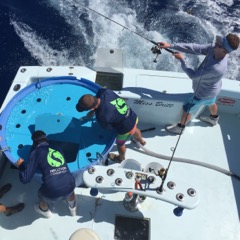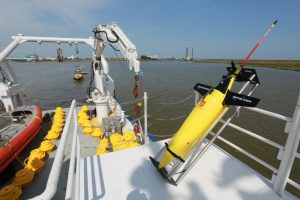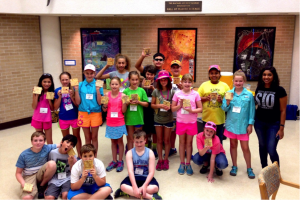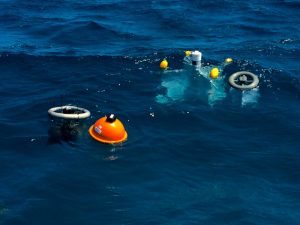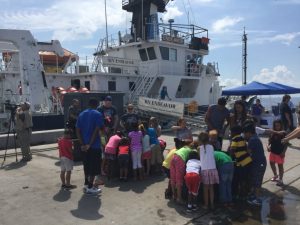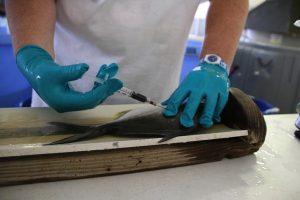Highlights from the 2015 Summer Field Season
– August 26, 2015
(From Summer 2015 Newsletter) Summer is a busy time for GoMRI scientists and they have been hard at work! Read on to see what some of the Consortia and RFP-II scientists have been up to this summer!
RECOVER
A team of scientists, professional anglers, and videographers recently embarked on a fishing trip to capture wild mahi-mahi broodstock for the University of Miami’s Experimental Hatchery program. The ongoing research is part of the RECOVER Consortium, which is focusing on the effects of crude oil on mahi-mahi and red drum in the wake of the 2010 Deepwater Horizon Oil Spill. RECOVER (Relationships of Effects of Cardiac Outcomes in fish for Validation of Ecological Risk) is a GoMRI consortia based at the University of Miami’s Rosenstiel School of Marine and Atmospheric Science. RECOVER scientists rely on the healthy population of wild mahi-mahi off the coast of Miami to repopulate breeding stocks in captivity. These fish will produce the tens of thousands of offspring that will be used in experimental trials relating to oil exposure at various life stages. The mahi-mahi are caught with rod and reel using circle hooks to ensure the least amount of harm and stress to the fish. They are then placed into a large custom-designed holding tank on the aft of the boat. The tank is constantly supplied with oxygen and seawater to further reduce stress and keep the fish healthy as they are transported back to the hatchery facility. Individual fish are transported from the capture vessel to land-based tanks at the hatchery where they are then placed into quarantine tanks for acclimation. Following the acclimation period, newly captured broodstock are introduced into specially designed maturation tanks equipped with advanced recirculating aquaculture systems (RAS) that allow for year-round spawning of the fish in captivity. The large volume of the tanks, which range in size from 8,000 to 21,000 gallons, and advanced life support systems allow the mahi-mahi to grow and reproduce naturally thereby providing a unique resource for research.
Provided by Daniel DiNicola, RECOVER Outreach Coordinator
LADC-GEMM
LADC-GEMM consortium has just returned from a successful 10-day Gulf of Mexico expedition onboard LUMCON R/V Pelican. The team of 14 scientists led by the consortium director Dr. Natalia Sidorovskaia (University of Louisiana at Lafayette) deployed five deep water moorings and a Seaglider in the vicinity of the Deepwater Horizon incident site. Both platforms will collect passive acoustic data for several months. The data will be later used by the LADC- GEMM scientists to continue monitoring the long-term effects of the 2010 oil spill on deep-diving marine mammals (dolphins, sperm whales, and beaked whales). During the field operations LADC-GEMM was also using a real-time acoustic data analysis from arrays towed by two autonomous surface vehicles (C-Worker 6 and C-Enduro). The team is excited to report that they had many visual and acoustic encounters with sperm whales and dolphins in the area.
Provided by Sara Heimlich and Natalia Sidorovskaia, LADC-GEMM Consortium
DROPPS
In June, DROPPS participated in the University of Texas Marine Science Institute’s Summer Science (UTMSI) program. On four separate occasions, Dr. Ed Buskey spoke to 3rd-8th graders about the DROPPS research and the importance of studying oil spills. CARTHE’s Laura Bracken and DROPPS’s Lalitha Asirvadam then gave a presentation about how scientists use “drifters” to study ocean currents. Laura presented to the students via Skype. The students then decorated their own drifters and deployed them off the pier at UTMSI.
In late June, DROPPS members from Texas Tech and John Hopkins University traveled to UTMSI and participated in a series of experiments. They used holographic technology, which allows visualization of the 3D distribution of tiny dispersed oil droplets suspended in seawater to take help understand what could have happened to plumes of oil mixed with dispersant released from the Deepwater Horizon well head. DROPPS researchers first tested their methods in smaller scale experiments in the laboratory and then in the 4 meter tall tower tank that was constructed for larger scale experiments studying the interaction of dispersed oil and marine plankton. In the tower tank experiments, they set up layers of slightly different seawater density to create a discreet thin layer of dispersed oil droplets to see how the micro oil droplets would disperse naturally, with and without small planktonic organisms swimming through it or with larger organisms such as jellyfish stirring up the water. This will help estimate the importance of biogenic mixing (mixing of the ocean by animals), an idea that has recently been of great interest to biologists and oceanographers.
On July 9, 2015 local news station Channel 3 TV visited UTMSI to conduct interviews for a story on the recent BP settlement. DROPPS Director Ed Buskey explained the importance of his research and how it is helping us understand the many dynamics of oil spill research. Graduate student Meredith Evans, who is involved in DROPPS, and UTMSI director Bob Dickey were also interviewed. It was aired on the evening news that night.
Provided by Lalitha Asirvadam, Program Coordinator DROPPS Consortium
CARTHE
CARTHE (Consortium for Advanced Research on Transport of Hydrocarbon in the Environment) has spent the summer preparing for LASER, LAgrangian Submesoscale ExpeRiment, planned for January 2016. This experiment will feature 1000 biodegradable, GPS-equipped, surface drifters and an aerostat, in addition to various other observational tools, to measure the surface currents in the northern Gulf of Mexico.
Over the past 2 years, CARTHE researchers have been designing new drifters for LASER and have spent much of July testing the latest version of these custom drifters. They have tested a full scale prototype in the field, while comparing it to previous designs, and tested half scale, 3D printed versions in the University of Miami’s SUSTAIN facility (a 23-m long wind wave tank). Aerial monitoring of the sea surface, drifters, and drift cards during LASER will be done from both manned and unmanned aircraft, including a Ship- Tethered Aerostat Remote Sensing System (STARRS). The CARTHE team spent a week this summer testing this custom- made platform that will acquire high-resolution images of the ocean’s surface using a 50 megapixel digital camera and an infrared camera, mounted on a 3-axis gimbal.
Observational data collected during all of CARTHE’s large- scale experiments are used to make more accurate computer models for predicting the fate of hydrocarbon released into the environment to help inform and guide response teams in the event of a future spill.
Provided by Laura Bracken, CARTHE Outreach Manager
ECOGIG
From May 29th to June 21st, the ECOGIG research team, made up of scientists and students from Georgia Tech, Lamont-Doherty Earth Observatory/Columbia University, the University of Georgia, Florida State University, and Coastal Carolina University conducted research in the northern Gulf from the R/V Endeavor. Under the leadership of Chief Scientist Dr. Joe Montoya, the research party set out to collect water column and sediment samples to further their understanding of the impacts of natural oil and gas seeps and anthropogenic oil and gas inputs on the water column and sea floor. The researchers carried out an intensive sampling and experimental program at natural oil and gas seeps in the Northern Gulf as well as at sites affected by the Macondo blowout. They collected water samples spanning the water column as well as sediment cores from the sea floor, allowing the researchers to explore the impact and fate of oil and gas in offshore environments. The shipboard work included water column and sediment processing. They deployed APEX floats (Autonomous Profiling Explorer) to profile the surrounding water column independent of the ship. Midway through the cruise, the ship made a port call in Gulfport, MS and participated in a media and education day, in celebration of World Oceans Day. ECOGIG researchers conducted dockside interviews and hosted an educational event including mini-Remotely Operated Vehicle building and ship tours with 210 kids from the local Boys and Girls Clubs.
On July 22nd, ECOGIG PhD student Ryan Sibert joined an on-going R/V Pelican cruise employing the ROV Global Explorer for a one-day sampling bonanza at the GC600 natural seep site. Ryan was able to photograph and video a seafloor monitoring system deployed by the ECOGIG “Lander” team, recover a time-lapse video camera that had been stranded at GC600 for more than a year, and collect Bathymodiolus brooksi mussels for experiments in the University of Georgia laboratory.
From July 27th to August 4th, ECOGIG PhD student Mary- Kate Rogener will participate in a Coastal Waters Consortium research cruise to the Mississippi River hypoxic zone. The general goals of this cruise are to document the temporal and spatial extent of the hypoxic zone that forms in the Northern Gulf of Mexico during the summer, and identify the hydrographic, chemical, and biological data related to the development and maintenance of the Gulf hypoxic zone. As part of Mary-Kate’s PhD research, she will determine rates of microbially-mediated N loss through the processes of denitrification and anammox and will also be determine rates of methane oxidation at multiple stations within the hypoxic waters.
Provided by Emily Davenport, ECOGIG Education and Outreach Assistant
C-IMAGE
This summer C-IMAGE looks to both continue established field operations and pioneer studies for continued research across the Gulf of Mexico. The main focus of C-IMAGE’s summer field operations are the annual Mud & Blood Expeditions studying ocean sediments (“Mud”) and fish toxicology (“Blood”) for two oil spills, IXTOC-I (1979) and Deepwater Horizon (2010). The Expedition incorporates three cruises, two to the southern Gulf, and one to the northern Gulf, totaling 51 days at sea. The first cruise aboard the R/V Justo Sierra studied the three-decade impacts from the IXTOC-I (1979) oil spill, which spilled a comparable oil volume as the Deepwater Horizon, by sampling deep-ocean sediment cores in the Bay of Campeche. Known as ‘Return to Ixtoc,’ this 14-day cruise was the first research expedition to the region since the 1979 well disaster. Future C-IMAGE summer cruises include continuing long-term, Deepwater Horizon impact studies on sediments and fishes of the northern Gulf, and beginning study of fishery connectivity and toxicology, post-IXTOC in the southern Gulf of Mexico.
Aside from the three summer cruises C-IMAGE summer field operations includes continued monitoring of artificial and natural habitat off the Texas coast with Texas A&M-Corpus Christi, inaugural oil exposure studies in fishes through MOTE Marine Aquarium, and utilizing Remotely Operated Vehicles (ROVs) to study fish abundance with Dauphin Island Sea Lab. Texas A&M-Corpus Christi and the Harte Research Institute has sampled and surveyed fish population using vertical longlines and fish traps, and SCUBA surveys and ROVs, respectively. Their goal is to determine how habitat type might influence growth and reproduction in areas unaffected by Deepwater Horizon and compare their findings with regions impacted by oils. MOTE Marine Laboratory began oil exposure studies to observe the changes in fish through ingestion, contact with oil in water, and contact with oil in sediments. Later this fall, Dauphin Island Sea Lab will survey and sample fish abundance and diversity in Gulf waters south of Alabama.
Provided by Ben Prueitt, C-IMAGE
RFP-II Investigators
Demetri Spyropoulos, RFP-II: We are in the midst of our summer undergraduate research program, in which two students attend lectures and perform field/lab research for 10 weeks. This summer we have Caitlin Sojka from California Sate University, Long Beach, CA and Amelia Burmbaugh from Maryville College in Maryville, TN. Caitlin is involved in identifying endocrine active compounds in COREXIT Water Accommodated Crude Oil and Amelia is involved in studying the impacts of DOSS (a likely obesogen) on alligator egg development. Both Caitlin and Amelia have gone out into the field to collect alligator eggs. Our recent DOSS ‘obesogen’ paper was published online, highlighting the work of GoMRI- supported Ph.D. student Lexi Temkin. She is lead author on the paper and Maggie, our summer student from last year is a co-author, as well as other NOAA/NIST collaborators.
Charles Meneveau, RFP-II: The RFP-II project team working on Large Eddy Simulations of turbulent dispersion of oil in the ocean’s surface layer is having a productive summer. The team includes Charles Meneveau of Johns Hopkins University, Marcelo Chamecki and Bicheng Chen of Penn State and Di Yang of the University of Houston. This summer the team has completed the study of effects of oil droplet size on dispersion plumes, with the publication of a 31-page article in the Journal of Geophysical Research: Oceans. The results reported include an important finding: the dilution rate and overall direction of transport of oil plumes in the ocean mixed layer are determined by competition between droplet rise velocity and vertical turbulent diffusion due to Langmuir turbulence. The simulations show how the minute, small-scale details can affect the large-scale properties of physical dispersion. Understanding how to relate small- scale physics to large-scale physics is crucial for predictive computer models of geophysical phenomena in general, and of the fate of oil spills in the ocean in particular. Also, the computer model has been successfully tested for predictions of oil plumes emanating from a source (like an underwater blowout) into water, including stratification and formation of horizontal intrusion layers where a lot of oil can remain trapped for extended periods of time (see figure). The team is collaborating with Scott Socolofsky of Texas A&M on further comparisons with laboratory data and engineering models.
Mindy Levine, RFP-II: The Levine group at the University of Rhode Island is hard at work this summer studying complex oils that have been collected directly from oil spill sites, and figuring out ways to use a large, cage-like ring molecule to remove toxic chemicals from those oils. We are looking at weathered oil, crude tar balls, and all kinds of purified and commercial oils as well, to test how general our method is. We are excited that some of these results were just published in the journal Marine Pollution Bulletin, and we are in the process of writing up two more papers about this work. Some other new science that we are working on is seeing how well our method works for fuel spills, and how the composition and behavior of fuel differs from crude oil. There was a fuel truck that spilled 12,000 gallons of fuel on Cape Cod recently, and we collected fuel samples from the spill site to assess the generality of our method. We are happy to report that even though the composition of fuel is very different from oil, there are enough similarities that we were able to easily adapt our environmental remediation method to remove toxic compounds from fuel as well. Finally, we are working on ways to detoxify the toxic compounds after they have been removed, and some of those results were recently published in the chemistry journal Tetrahedron Letters.

